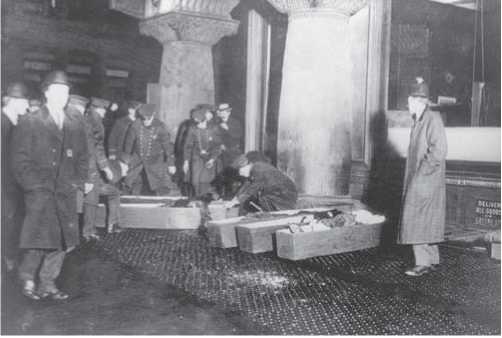A half-hour before quitting time on a Saturday afternoon, March 25, 1911, 147 New York City garment workers perished in a massive fire in one of the city’s most notorious sweatshops, the Triangle Shirtwaist Company. The workers were mostly young immigrant women, who worked long hours in hot, cramped, and dusty conditions for low wages. They perished as the result of a fire that began in a bin and spread wildly throughout the factory, lasting only thirty minutes “from spark to ember.” As the factory’s workers frantically searched for a means of escape, they found that the doors, stairs, and elevators had been blocked by their employers, in what was then a common practice to ensure greater productivity.

Photograph of police placing Triangle Shirtwaist Company fire victims in coffins, March 25, 1911 (Library of Congress)
The Triangle Shirtwaist Factory occupied the eighth, ninth, and 10th floors of the Asche Building on New York’s Lower East Side. Many of those on the eighth and 10th floors of the building eventually found a way out alive, but the majority of the workers on the ninth floor were not so fortunate. They died from the effects of the fire, or from being crushed as they attempted to slide down the elevator cables, or leapt to their deaths on the pavement below, tangled in each other’s arms with flames streaming dramatically from their hair and clothes. Hordes of onlookers witnessed the gruesome sight as fire trucks’ efforts were made futile by the bodies strewn on the sidewalk and street, and an escape ladder that could only reach to the sixth floor of the building. The public process of identification of victims by their families was painfully long as the number of victims was so great, and many had been burned or crushed beyond recognition, identifiable only by small details such as the mending of a shoe.
The owners of Triangle, Isaac Harris and Max Blanck, were known as the “Shirtwaist Kings” for their large, efficient garment factories. For their role in creating the hazards that led to the fire, the two men were indicted for manslaughter but later acquitted by a jury. Most employers of the time were not held accountable for the safety of their workplaces. A later civil suit awarded only $75 to victims’ survivors who filed a claim.
The Women’s Trade Union League held a public funeral demonstration in which 100,000 workers took to the East Side streets demanding protection for industrial workers. The huge outcry among workers and Progressive reformers in New York led to the creation of the “Committee of Fifty,” organized out of a large crowd that convened in the Metropolitan Opera House just days after the fire. The committee comprised leaders from labor, business, civic, and religious organizations. Its leaders immediately demanded that the state legislature conduct a formal investigation. The New York State Investigating Committee was headed by assemblyman Alfred E. Smith and Senator Robert F. Wagner. In subsequent years, the committee was active in proposing 56 laws and aided in the creation of the best industrial safety codes in the nation, which included the installation of fire alarms and sprinklers and the banning of locked doors during working hours. The support for these broad reforms by Tammany Hall boss Charles Murphy inspired the trust of a new generation of immigrants in the Democratic Party’s political machine.
While the tragedy of the Triangle Shirtwaist Fire was almost unprecedented at the time, the public’s outcry did not guarantee that changes in the safety of industrial working conditions actually would take place. Indeed, previous tragedies had caused citizen outrage, only to be slowly forgotten. Just four months before the Triangle Fire, 25 young women in Newark had similarly lost their lives in a garment factory fire. The changes in the industrial workplace that followed the Triangle Shirtwaist Fire can be seen as a critical moment in which working-class organizers protested against dangerous working conditions and joined middle-class reformers and pragmatic politicians in making incremental changes. In 1909 and again in 1910, wealthy Progressive reformers and the working women of the Triangle Shirtwaist Factory led shocking strikes that were violently put down but prompted tens of thousands of male and female garment workers in the city to leave their jobs and make demands. Moreover, from 1909 to 1913, the numbers of unionized workers in New York grew from 30,000 to a quarter of a million. At a time when workplace safety was unregulated and worker’s compensation virtually nonexistent, America’s workers organized among themselves to make their own demands. The reforms implemented in New York were replicated in urban centers across the nation.
See also LABOR and labor movement; occupational health and salety; Shirtwaist Makers Strike.
Further reading: Richard A. Greenwald, The Triangle Fire, the Protocols of Peace, and Industrial Democracy in Progressive Era New York (Philadelphia: Temple University Press, 2005); Arthur F. McEvoy, The Triangle Shirtwaist Fire of 1911: Social Change, Industrial Accidents, and the Evolution of Common Sense Causality (Chicago: American Bar Association, 1993); Dave Von Drehle, Triangle: The Fire That Changed America (New York: Atlantic Monthly Press, 2003).
—Monica Foley
Trotter, William Monroe (1872-1934) civil rights activist
Reform journalist and civil rights leader William Monroe Trotter was born in Chillicothe, Ohio, in 1872, the son of James Monroe Trotter and Virginia Isaacs. His parents, who originally settled in Massachusetts, returned to Boston shortly after William’s birth. His father, James, served in the African-American 55th Massachusetts Regiment in the Civil War. He was a strong advocate for racial equality and a Republican partisan, as evidenced by his appointment as Recorder of Deeds. William Monroe Trotter followed his father’s example in challenging the racial norms of the time. Seeking a career in international banking, William graduated from Harvard University summa cum laude in 1895 and earned his master’s degree there in 1896. Encountering racial discrimination in the business world, Trotter pursued a career first in real estate and then in newspaper publishing. Trotter married Geraldine Louise Pindell in 1899.
In 1901, Trotter and George Forbes, an Amherst graduate, founded the Boston Guardian, a black newspaper that targeted the racism of its time. Challenging the conservative approach of Booker T. Washington, Trotter and Forbes focused their ire on Washington’s accommodation to segregation and his tacit acceptance of second-class citizenship for African Americans. The newspaper influenced public opinion far beyond Boston and its black population. As W. E. B. DuBois, later the leader of the National Association lor the Advancement ol Colored People (NAACP), wrote, “The Guardian was bitter, satirical, and personal; but it was earnest, and it published facts. It attracted wide attention among colored people; it circulated among them all over the country; it was quoted and discussed.”
As an ally of DuBois, Trotter participated in the founding of the Niagara Movement in 1905. He left the movement to form his own National Equal Rights League, which focused on direct action and on the role of the presidency in civil rights. When the Niagara Movement formed the NAACP in 1909, Trotter attended its first founding meeting; but he and the Equal Rights League were often at odds with the NAACP’s agenda. Trotter remained active in politics, supporting the election of Woodrow Wilson in 1912. When the Wilson administration began to segregate federal office buildings and the number of black federal workers rapidly declined, Trotter led protests against the president’s discriminatory policies. In 1915, he coordinated nationwide protests of the film Birth of a Nation, based on Thomas Dixon’s racist novel, The Clansman. Later, in the 1930s, Trotter organized support for the defense of the Scottsboro boys, who had been unjustly accused of sexual assault.
After Trotter’s death in 1934, DuBois wrote that “Monroe Trotter was a man of heroic proportions and probably one of the most selfless Negro leaders during all our American history.” His militant advocacy of racial equality helped to further the cause of civil rights in the first three decades of the 20th century.
See also race and racial conllict.
Further reading: Stephen R. Fox, The Guardian of Boston: William Monroe Trotter (New York, Scribners, 1971); Nicholas Patler, Jim Crow and the Wilson Administration: Protesting Federal Discrimination in the Early Twentieth Century (Boulder: University Press of Colorado, 2007).
Trusts See Volume VI.
Twain, Mark See Volume VI.




 World History
World History









